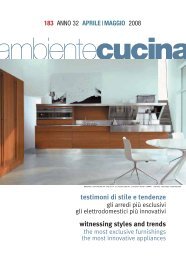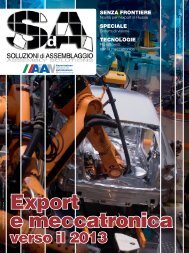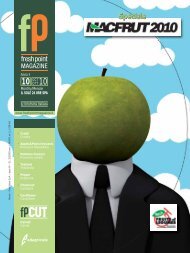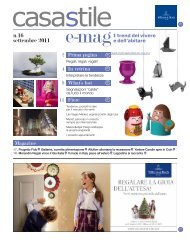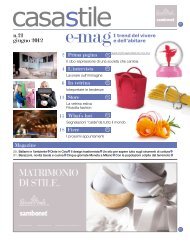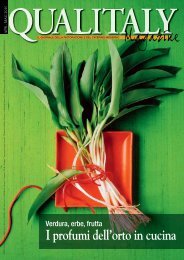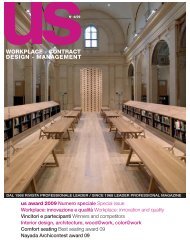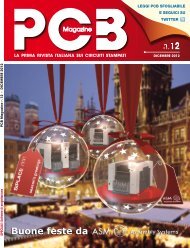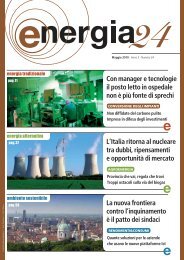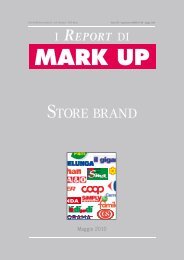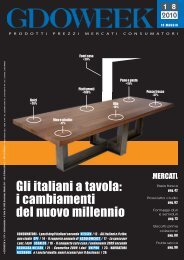super laminato - B2B24 - Il Sole 24 Ore
super laminato - B2B24 - Il Sole 24 Ore
super laminato - B2B24 - Il Sole 24 Ore
You also want an ePaper? Increase the reach of your titles
YUMPU automatically turns print PDFs into web optimized ePapers that Google loves.
Ph Meccanica<br />
L’ECCELLENZA DEL LAMINATO<br />
The excellence of laminate<br />
Conosciuto inizialmente anche con il nome<br />
commerciale di “Formica” (dall’azienda che ne<br />
brevettò la prima versione nel 1927) il <strong>laminato</strong> è<br />
composto da resine fenoliche (supporto) e<br />
melaminiche (carta estetica decorativa) incollate<br />
tra loro in modo tale da formare fogli di circa 0,6<br />
mm e impiegate per il rivestimento di pannelli<br />
legnosi (truciolato, Mdf, tamburato). Le ottime<br />
caratteristiche e il costo contenuto ne hanno fatto<br />
il materiale più utilizzato in cucina.<br />
Solo quei laminati, però, che possono fregiarsi<br />
del marchio HPL hanno qualità <strong>super</strong>iore<br />
con eccezionali doti di durezza e resistenza<br />
al graffio, all’usura, all’urto, agli agenti chimici,<br />
al fuoco (l’eccellenza negli standards<br />
sono definiti dalla norma EN 438/1).<br />
HPL sta per High Pressure Laminate<br />
perché viene sottoposto a una pressatura molto<br />
elevata, con presse piane e non a rullo,<br />
e per questo risulta molto più resistente.<br />
Nei casi in cui lo spessore delle resine di supporto<br />
sia <strong>super</strong>iore a 1 mm si parla di <strong>laminato</strong><br />
stratificato. Grazie alle loro caratteristiche<br />
meccaniche possono essere impiegati<br />
come pannelli autoportanti senza dover essere<br />
applicati ai pannelli legnosi. <strong>Il</strong> <strong>laminato</strong> stratificato<br />
per le sue doti di estrema resistenza<br />
è molto adatto all’uso in cucina.<br />
Di recente la tecnologia ha permesso di ottenere<br />
anche dalle presse a rullo utilizzate per il <strong>laminato</strong><br />
CPL, acronimo di “Continuous Pressure Laminate”,<br />
pressioni e laminati con caratteristiche<br />
paragonabili a quelle del HPL.<br />
Da ciò è nato un prodotto conosciuto<br />
come CHPL (Continuous High Pressure Laminate).<br />
Infine, sono importanti per stabilirne la resistenza<br />
anche i collanti impiegati per mettere insieme<br />
i vari strati. I migliori sono i collanti poliuretanici<br />
che risultano molto resistenti all’umidità,<br />
all’acqua, al vapore e al calore.<br />
Known also by its trade name “Formica”,<br />
laminate is made of phenolic resins (the base)<br />
and melamine resins (the upper decorative paper<br />
layer) glued together to make sheets roughly<br />
0.6 mm thick and used to clad wood-based<br />
panels (particleboard, MDF, hollow-core plywood).<br />
Its high-quality properties and affordability<br />
make it one of the most widely used materials<br />
in kitchen manufacturing.<br />
However, only laminates that can genuinely<br />
be designated HPL offer exceptional qualities<br />
of hardness and resistance to scratching, knocks,<br />
chemical attack, fire and general wear and tear<br />
(excellence is defined by EN 438/1 standards).<br />
HPL stands for High Pressure Laminate,<br />
which means it is subjected to extremely<br />
high pressure with flat presses rather than rollers,<br />
and is much tougher as a result.<br />
In cases in which the thickness of the support<br />
resins is higher than 1 mm the product<br />
is termed stratified laminate.<br />
Its mechanical strength makes it suitable<br />
for the creation of self-supporting panels that<br />
do not need to be mounted onto wood-based<br />
panels. Because of its extremely<br />
high resistance it is particularly appropriate<br />
for use on kitchens.<br />
Technology has also made it possible to use<br />
the roller presses employed in the making<br />
of CPL (Continuous Pressure Laminate), to make<br />
laminate products with properties comparable<br />
to those of HPL. The resulting product is known<br />
as CHPL (Continuous High Pressure Laminate).<br />
Finally, the resistance of laminates is also<br />
the result of the adhesives used to glue<br />
the various layers together.<br />
The best adhesives are polyurethane glues,<br />
which are highly resistant to humidity, water,<br />
steam and heat.<br />
SUPER LAMINATE<br />
- duro<br />
- compatto<br />
- omogeneo<br />
- non poroso<br />
- ad alta densità<br />
- resistenza all’usura<br />
- resistenza ai graffi<br />
- resistenza agli urti<br />
- resistenza<br />
alle infiltrazioni<br />
- resistenza alle macchie<br />
- resistenza all’umidità<br />
- resistenza al vapore<br />
- resistenza a un calore<br />
non troppo elevato<br />
- igiene<br />
- antistatico, cioè<br />
non attira la polvere<br />
- stabile<br />
- impermeabile<br />
- infiammabile solo<br />
con fiamma diretta.<br />
IN TEMA<br />
LE CARATTERISTICHE DEL LAMINATO HPL<br />
PROPERTIES OF HPL<br />
- hard<br />
- compact<br />
- homogeneous<br />
- non-porous<br />
- high density<br />
- hard-wearing<br />
- stratchproof<br />
- knockproof<br />
- resistance<br />
to seepage<br />
- stainproof<br />
- dampproof<br />
- steamproof<br />
- resistance to high but not<br />
excessive temperatures<br />
- hygienic<br />
- antistatic<br />
(does not attract dust)<br />
-stable<br />
- impermeable<br />
- ignites only when<br />
exposed to a direct flame<br />
ambientecucina 93



